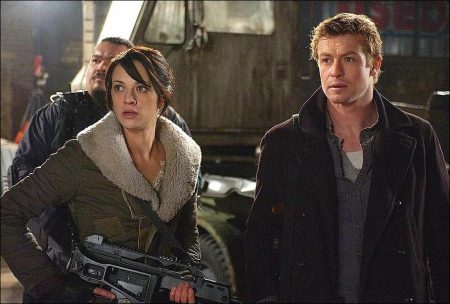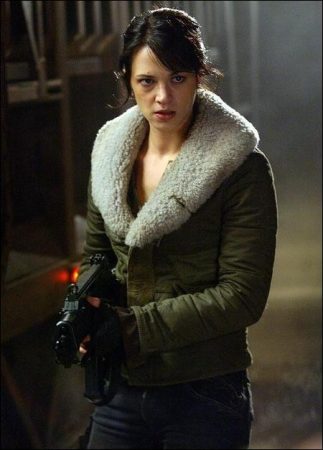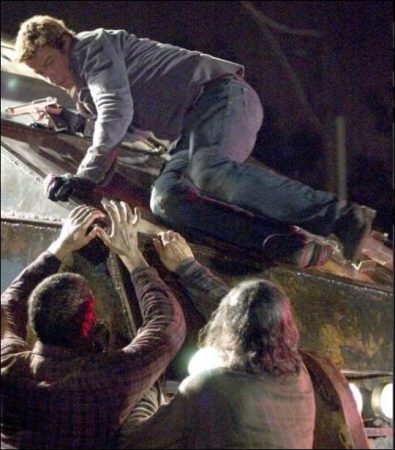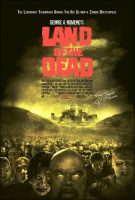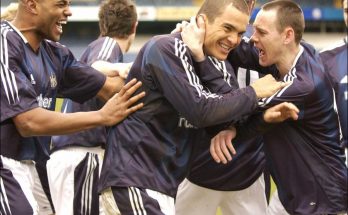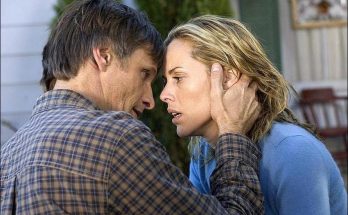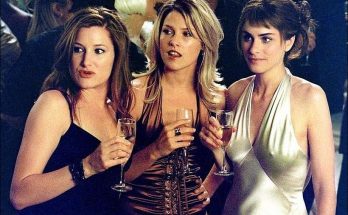Tagline: The Legendary Filmaker Brings You His Ultimate Zombie Masterpiece.
It has been two decades since master filmmaker George A. Romero’s zombies have stalked the screens of motion picture theaters. For years, fans around the world have been eagerly awaiting his return. And now that day is here. An all-new chapter of horror is about to begin…
George A. Romero’s Land of the Dead is the acclaimed director’s long-awaited return to the genre he invented, beginning with the seminal Night of the Living Dead and continuing with Dawn of the Dead and Day of the Dead.
In Romero’s harrowing newest vision, the world (as humankind has known it) is merely a memory. In its place is the never-ending nightmare existence of us-the living-versus them-the “walkers.”
What’s left of mankind is cordoned off behind the walls of a fortified city while the walking dead roam the vast wasteland beyond. The few wealthy and powerful try to maintain an illusion of life as it was, dwelling high above the city in the exclusive towers of Fiddler’s Green, the last bastion of the ruling class.
On the streets below, however, the remaining, less fortunate of the city’s inhabitants eke out a hard-scrabble life, seeking what little solace they can in the vices available-gambling, flesh trade, drugs-anything that offers even a fleeting respite from the hell their lives have become.
Both the lofty heights of Fiddler’s Green and the demoralizing lows of the city below are lorded over by a handful of ruthless opportunists, led by Kaufman (Dennis Hopper), who keeps his hands in everything, from real estate to less above-board pursuits.
To bring food and other essential supplies to the occupants of the city and to allow the Green’s well-to-do to acquire the scarce luxury items to which they were once accustomed, a hardened group of mercenaries-headed by Riley (Simon Baker) and his second-in-command, Cholo (John Leguizamo)-run retrieval missions outside the city, protected by their massive armored vehicle, Dead Reckoning. Riley and Cholo, like Kaufman, are in it for the money, which they hope to use for their own escapes-Riley to the North, with promises of “a world without fences” and freedom, and Cholo to the luxury of Fiddler’s Green, far away from the violent life he has known.
While Kaufman and his employees concern themselves with commerce, life is changing both within and beyond the walls of the city. Unrest and anarchy are on the rise among the city’s disenfranchised and outside, the army of the dead is changing, evolving, learning to organize and communicate.
When Cholo commandeers Dead Reckoning, intent on extorting millions out of Kaufman and his cronies, Riley and his ragtag group-including Slack (Asia Argento) and Charlie (Robert Joy)-are called into action to stop Cholo and, in the process, protect the city and its population from the growing army of evolving zombies storming its weakening perimeter.
About the Production
For many film fans, the evolution of the modern horror film-with its combustible mix of unrelenting scares and sly social commentary-began with a 1968 independent film, shot in black and white on an ultra-low budget (around $100,000). It featured a group of panicked strangers holing up in an isolated farmhouse to elude a throng of attacking, flesh-eating zombies-it was called Night of the Living Dead.
The groundbreaking film was directed and co-written by a 28-year-old industrial filmmaker named George Romero, who also served as its cinematographer and co-editor and even appeared in a cameo as a news reporter. The film only grew in acclaim following its release, taking on a life of its own among cineastes, film students and revival house moviegoers. In 1999, Night of the Living Dead was inducted into the United States’ National Film Registry. With that film, a genre was born.
Romero wryly observes, “I’ve always considered myself this guy who happens to be a filmmaker who lives in Pittsburgh. I’m grateful that there is ongoing interest in what I do-I guess, to my fans, I’m sort of a Pancho Villa kind of figure, always just under the radar. But all the films I’ve done, I’ve really cared about, and hopefully there’s some good work in there that people can enjoy. My stuff has had an extraordinary shelf life and I can’t really explain why; partly, I guess, because I’m this rogue guy, but also because some people find what I do interesting-there’s something there, if you want to think about it…something underneath it all.”
Romero continued to use the zombie film as a prism (albeit a truly horrifying one) through which to explore current-day mores in the follow-up features Dawn of the Dead (1978) and Day of the Dead (1985). Twenty years have passed since the third film in Romero’s series-and now, the master has returned to the genre he created.
“I started something with Night of the Living Dead that I couldn’t have foreseen,” observes George Romero. “What I have tried to do is to reflect on the socio-political climate of the different eras. The stories are similar, but they are set in different decades. It’s an unusual conceit, but I like being able to make the film current, politically speaking, even though the story is continuous.”
The filmmaker continues, “Land of the Dead is set in a devastated world. There’s no electricity except for places inside the city where people are trying to live normal lives. That is their error…it goes back to the idea of ignoring terrorism and other societal problems outside your own door. They think, `If we ignore it, we’ll be okay.’ They’re forming small civilizations on their own, turning their backs, really, on the problems outside. That’s at the core of what the movie is about. The protagonists are the ones that have to go out into the dark side of the world to bring back food, supplies.”
Producer Mark Canton recalls the fast-track genesis of the project: “I’ve always had great esteem for Romero and had been crossing paths with him over the years. Last summer, I was having lunch with George’s agent, who told me that Romero had a script that was ready to go. I read it overnight and called him back the next morning and said, `Let’s make it.’ Literally within hours of announcing the production in the trades, Universal, who’d had great success with this kind of picture, stepped up to the plate. And Wild Bunch had been involved on the international side from the get-go. It was a case of announcement in July, deals signed in August and shooting in October. The script and the project had a buzz-with George, the master, at the helm, people were calling us.”
Romero’s producing partner and film producer Peter Grunwald points to the filmmaker’s narrative skills as another important element in the success of his features. Grunwald offers, “George is first and foremost a storyteller. He happens to work in and love the horror genre, but he’s a great craftsman and a sensational stylist, and I think he would be those things in any genre. George had had a lot of interest over the years from the studios and the fans to make another zombie film. He’s extremely loyal not only to his fans, but to those films-he prizes them both-and he didn’t want to make another film until he was sure he could do it well, until he had something new to say, to add to the series.”
Producer Bernie Goldmann is a native of Pittsburgh (Romero’s adopted hometown) and has always held the filmmaker in high regard. He welcomed the chance to work with Romero and says, “While there have been some recent films that feature zombies in their storylines, they’ve come from filmmakers just discovering the genre. George not only invented the genre, he’s looking to push its boundaries and say something new. He’s revered because there’s an element of classic science fiction underneath his zombie movies, so while there’s the gore, the fun, the jokes, the scares, it’s also reflective of society today. He elevates the genre in that way. This combination sets his work apart.
Canton adds, “George’s body of work is supported by this mythology that is furthered by each film. This time, the undead are evolving, remembering what it’s like to be human again. That’s something that’s uniquely Romero and indicative of the investment of time and craft in his work.”
When the Dead Walk: Casting the Film
As a director crafting the latest installment in an acclaimed body of work, Romero found himself in an enviable position-he was able to pick and choose his filmmaking team and cast… a definite change from when he was a new filmmaker in the 1960s trying to break ground with a film about zombies.
Romero’s reputation for crafting socially relevant plots resulted in a wealth of casting possibilities to consider. “I was able to get my first choice for each of the characters-that doesn’t happen very often,” he states.
Canton adds, “George’s unique iconic situation in the industry attracted the best actors, so casting was an amazing process for everyone.”
Simon Baker was always at the top of the list to play Riley, commander of Dead Reckoning and the hero of the story. Canton and Goldmann were familiar with Baker’s work from Red Planet, a film on which they had all previously collaborated. “They thought very highly of him. He was just sensational, a great actor, perfect for the role but he’s also a wonderful guy. He’s great to have on the set. He keeps everybody up and light, and he has a terrific sense of humor,” comments Grunwald.
A native of Australia, Baker was mostly unfamiliar with Romero’s work, but after a crash course in the filmmaker’s oeuvre, quickly became enthused about the prospect of appearing in a George Romero film. “George’s films could be classified in the horror genre, but really, he’s a genre unto himself. I had an early experience with Dawn of the Dead, which I saw when I was 17, and I couldn’t get over it-I remember it vividly. But I hadn’t really revisited his films until my manager sent me the script for Land of the Dead. After I met with George, which was a great experience, I went home and watched all of his movies. Then, well, I was hooked. I had to do it.”
Romero’s meeting with Dennis Hopper was orchestrated by Canton, a longtime friend. “Mark felt that Dennis and I had a lot in common,” recalls Romero.
“I think that Night of the Living Dead and Easy Rider are among the signature movies of the `60s generation,” observes Canton. In keeping with Canton’s hunch, the men found an easy rapport and after a successful meeting, Hopper agreed to take on the role of Kaufman, the self-appointed leader of Fiddler’s Green, the enclave of the privileged few.
Hopper approached the role by thinking of Kaufman as a corporate CEO-a man who assumes the responsibility of keeping the residents of Fiddler’s Green safe. “I’m not playing him like a bad guy-I don’t think he sees himself as a bad guy. He built fences to keep people safe; he’s hired the army and pays to train them. He keeps the citizens on the street occupied by giving them games and vices. He’s trying to do the best he can.”
For the role of Slack, an ex-prostitute who becomes an invaluable member of Riley’s team, Romero chose Asia Argento, who, through her family tree, shared a bit of history with the filmmaker. “Asia was always my first choice. I have known her for a long time-her father [Italian filmmaker] Dario Argento helped to finance and produce my version of Dawn of the Dead. I thought it would be great to have her in the movie,” explains Romero.
For Grunwald, Argento fits the mold: “She’s very much a Romero heroine in that she fends for herself. She’s as tough as anybody else in the movie. Tougher.”
Argento, who has appeared in three horror films by her father, Italy’s foremost horror director, describes Romero as “a god. I was incredibly flattered George called me to do the film. I’ve been a fan since I was about eight-I remember sneaking the Beta of Dawn of the Dead. I grew up with his movies and they meant a lot to me. By feeling fear so young, I became a more courageous person. There’s something about zombies that touches us very deeply. It’s something very ancient in us-the fear of dead people coming back to life,” comments Argento.
Romero had previously worked with Robert Joy on his film The Dark Half and offered him the role of Charlie, Riley’s protective and loyal friend. Joy’s acceptance of the role was largely based on his past experience working with Romero. He explains, “George likes working with actors-whatever you bring to him fires his imagination and makes the collaboration that much more rich. To work on any film with George would be a pleasure. But since the first time I worked with him was not a zombie movie-well, it made it even more exciting to work with him again on this project.”
Charlie’s close-knit relationship with Riley begins when Riley saves his life. Joy offers, “That act starts and defines the relationship between them, and Charlie feels that he has to protect Riley unto death. It’s the fiercest kind of loyalty because Charlie really would give up his life for Riley.”
“It’s as if I created the character of Cholo with John Leguizamo in mind, but I wasn’t sure that it would happen,” says Romero. “John projects a sense of being roguish, yet is sympathetic at the same time. I also thought that he could bring a dose of droll humor to the film.” After the film’s producers connected with the prolific actor, they discovered that Leguizamo was a huge fan of Romero’s work-so his role as Cholo was, in some ways, meant to be.
On reading the script, Leguizamo readily responded to the multi-layered story. He explains, “It had political undertones, well-defined characters, action, conflict and racism. My character is full of self-hate, and has ambitions to take over Riley’s job. Then, there’s Kaufman world, which is right-wing, neo-conservative and rich. The script shows the haves, have-nots, the have-mores…and then the zombies. I just loved the many levels to this movie.”
Producer Goldmann observes, “We ended up with our amazing cast because of their passion to work with George. He instills that kind of excitement, which gives us the best of worlds when it comes to putting the film together. It’s like we’re choosing from this great pool of talent, all of whom really want the experience of being in a Romero film.”
Once cast, Baker, Argento, Joy and Leguizamo began a period of weapons training prior to filming. Additionally, Leguizamo had to learn to ride a motorbike. To prepare for the arena sequence, where her character is pitted against two zombies in chains, Argento also trained in martial arts, boxing and weights. “Even before this project, I trained pretty hard. Now, doing this, I finally got to show all that I’ve worked for all these years. It had never really been asked of me. The physical part of Slack has been really fun to do.”
Much as Romero has evolved into a peerless horror filmmaker, his zombies have advanced from the stumbling, somewhat mindless creatures to ones that now possess a slowly dawning consciousness and rudimentary planning and organizational skills. Once Big Daddy (played by Eugene Clark)-an aptly named walking dead man of rather large stature-decides to fight back, he becomes a galvanizing force within the zombie ranks. After he witnesses a routine slaughter of a “stench” (one of several less-than-flattering synonyms for zombie), he begins a march toward the city, signaling to other walkers to join in the ever-expanding army. Their unspoken aim? Retribution.
Once word was out that the Romero was indeed making another film, the production office was deluged with an ongoing stream of requests by those wanting to be a Romero zombie-and not just from actors. Edgar Wright and Simon Pegg (whose film, Shaun of the Dead, was a loving tribute to Romero’s oeuvre) made the pilgrimage to the set to appear in the arena scenes as Photo Booth Zombies. Makeup specialist Tom Savini (responsible for designing the look of Romero’s early zombies and now an actor and director in his own right) also makes a cameo appearance as a machete-wielding zombie.
Land of the Dead attempts a balancing act for its writer/director, whose overriding aim is to satisfy hard-core enthusiasts of the genre, as well as introduce new audiences to his zombie universe. “What we are trying to do is let George be the best he can be with the genre that he created. He’s the master of what he does. The passion for this genre is unbelievable, and it’s all because George figured out a way to create a world that was scary, horrific, hip and cool. He’s remains that guy,” comments Canton.
Grunwald agrees, “Zombies have always been my favorite movie monster, because they’re not exotic. They’re the people next door. They’re us. Frankenstein is a creature of science, and Dracula is a creature of myth and legend. Zombies are just normal folks. That’s where their power to scare comes from.”
Goldmann adds, “We live in a violent society, which has always been a part of George’s films. What’s really scary about zombies, though, is not just that they’re violent creatures-they’re relentless. They call up all those nightmares as a child, trying to run away from something that just keeps coming and never stops.”
Romero closes, “My films are not at all traditional horror films, slashers or anything. I just think of them as stories, basically-people stories underneath it all. The early horror films, as beautiful as they were, were about a crisis that could possibly destroy the world; it was all about restoring order. The real horror in my films is that order is never going to be restored.”
George A. Romero’s Land of the Dead (2005)
Directed by: George A. Romero
Starring: Simon Baker, Asia Argento, Dennis Hopper, John Leguizamo, Joanne Boland, Jennifer Baxter, Boyd Banks, Jasmin Geljo, Maxwell McCabe-Lokos, Pedro Miguel Arce, Shawn Roberts
Screenplay by: George A. Romero
Production Design by: Arvinder Grewal
Cinematography by: Miroslaw Baszak
Film Editing by: Michael Doherty
Costume Design by: Alex Kavanagh
Set Decoration by: Marlene Puritt
Art Direction by: Douglas Slater
Music by: Reinhold Heil, Johnny Klimek
MPAA Rating: R for pervasive strong violence and gore, language, brief sexuality and some drug use.
Distributed by: Universal Pictures
Release Date: June 24, 2005
Visits: 45
